Chapter 15 - Logarithmic and Exponential Functions
Chapter 15 - Logarithmic and Exponential Functions
The
previous chapter was devoted to defining a new type of function, the
exponential function. The base of this function was multiplication. We can
describe
the exponential function as simply:

This is defined for all values of x, as defined in
the previous chapter. Let us now look at the inverse of this function or
what
we shall refer to as the Logarithmic of this function. Remember the
inverse
function is found by interchanging y and x so we
get:

By solving for y to get the inverse function we
get:

This tells us that we must do something to an
inputted x value to find y. Remember x refers to the number we get by
raising a
to some power y. Therefore if we were given x then in order to get y, we
must
ask ourselves to what power has, a, been raised to so as to get y? This
question can be replaced with the word . Log., where the Log, base a, of a
number is the power a or the base has been raised to so as to get x.
Stated
mathematically:

The question marks refers to our output or y values.
Remember we are inputting values of x, making x our independent variable,
then calculating
what power the base must be raised to get x. This answer is our dependent
variable as its value depends on what number x we have inputted.
Hence:

This is really not that difficult, just remember
that the Logarithmic function is the inverse or opposite of the
exponential
function.
Now
let us move on to examine some unique properties of the
Logarithm.

Or the Log of a product is simply the sum of the
Log.s of each number. To understand this, recall the property of
exponential
multiplication, where the product of two exponential numbers of the same
base
is simply the sum of the exponents with the same
base.

 we begin by assuming that c
and d can be expressed as some exponent of the base. Remember that
we begin by assuming that c
and d can be expressed as some exponent of the base. Remember that
 . Therefore we can let:
. Therefore we can let:

This means that
 by substituting c and d for
by substituting c and d for
 and
and
 respectively. Then:
respectively. Then:

The second important property of Logarithms is
that:

The proof is based on property 1, excepts that we
must keep in mind that
 . Thus
. Thus
 is expressed as
difference of two Logarithms and not a sum, since we are dividing not
multiplying.
is expressed as
difference of two Logarithms and not a sum, since we are dividing not
multiplying.
The
final and most important property of Logarithms is
that:

The proof of this extremely useful property requires
us to first re-write
 as
as
 where
where
 .
When we raise x to the n'th power we must raise the left side of the equation also
to
the n'th power:
.
When we raise x to the n'th power we must raise the left side of the equation also
to
the n'th power:

This is based on
the third property of exponential functions that tells us that an
exponents raised to an exponent can be reduced to the product of the
exponents.
We can now write
 as
as
 which is the same as
which is the same as

Having proved the unique propertied of Logarithms,
all of which related to the property of exponents, we shall now calculate
the
derivative of the logarithmic function. We begin with the
function:

From the definition of the derivative:

Using this we get:

From the second property of Logarithms the
numerator:

Can be simplified to:

Substituting this back into the definition of the
derivative we get:

Recall the third property of Logarithms;
 Consequently:
Consequently:

Clearly as
 goes to zero,
goes to zero,
 / x
also goes to zero regardless of what value x is. Outside the
brackets, 1/
/ x
also goes to zero regardless of what value x is. Outside the
brackets, 1/ tends to infinity as
tends to infinity as
 goes to zero. This means we can rewrite:
goes to zero. This means we can rewrite:

x /  is therefore the reciprocal of
is therefore the reciprocal of  / x
and it also tends to infinity
as
/ x
and it also tends to infinity
as  approaches zero, regardless of what value x takes on. Thus from
the third property of Logarithms:
approaches zero, regardless of what value x takes on. Thus from
the third property of Logarithms:

We shall now make a small change in variables to
help evaluate the limit inside the Log brackets. We replace
 / x with 1/n and x /
/ x with 1/n and x /  with n. The derivative can now be re-written as:
with n. The derivative can now be re-written as:

which now becomes

Let us now evaluate the limit an n -> infinity of
 . By the Binomial Theorem we get:
. By the Binomial Theorem we get:



The
sum of the terms after the first two will always be less than the sum of the corresponding infinite
series
 whose sum can be proven to
be one. Just think that it will take an infinite number of steps to cover
one
meter if in each step you can only cover half the remaining
distance.
whose sum can be proven to
be one. Just think that it will take an infinite number of steps to cover
one
meter if in each step you can only cover half the remaining
distance.

This is true because:
 . The same reasoning can be applied to the remaining n terms;
the numerator will always be less than one and the denominator will be
greater
than the denominator of the corresponding n.th term in the series. For
example:
. The same reasoning can be applied to the remaining n terms;
the numerator will always be less than one and the denominator will be
greater
than the denominator of the corresponding n.th term in the series. For
example:

Since the sum of this series is 1, we can make an
important conclusion,

As we shall see later, this limit tends to the
number e, where e=2.71828...Returning back to our derivative we
get.

Therefore:

If the base a was set equal to e, we would have:
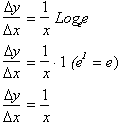
For this reason we denote the Logarithm of base, e,
to be called the Natural Logarithm or ln x , whose derivative is simply
1/x
.The derivative of logarithms of other bases is
 , where the Log e is some other constant other than
1.
, where the Log e is some other constant other than
1.
Having
shown that the derivative of ln x is 1/x we can go on to prove the
derivative
of the inverse of the logarithm function, the exponential function, using
our
algorithm presented in the chapter on inverse functions. Before doing it
that
way let us use the definition of the derivative to find the exponential
function.s derivative.
To do
this we follow similar steps to those we used to calculate the derivative
of
the Logarithm of base a, function. Instead of


Recall the first property of exponential
multiplication, where

Therefore
 and
and
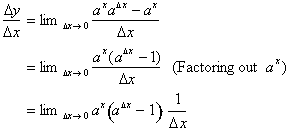
As  gets closer and closer to zero,
gets closer and closer to zero,

We will now make a small change in variable to
simplify the limit calculation. We replace
 with
with
 . We now have:
. We now have:

Let us now evaluate the limit in the brackets.

The value within the parenthesis will tend to zero
or
 since for example
since for example
 . We now want to solve
. We now want to solve
 for
for

 and the derivative
will be
and the derivative
will be

Solving the part in parenthesis gives us:

Raising both sides to the n.th power, we get:

Remember we are taking the limit as n goes to
infinity so we have:

This tell us that if the base a were equal to e the
derivative of


Becomes:

The reason
we get 1 is because:

Setting a equal to e gives us:
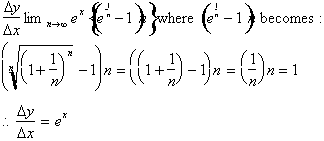
Remember this only happens when a=e. The derivative
of
 is
is
 or the function itself. This
tells us that the rate of change of the function at a point x is
proportional
to the function.s value at that point. This will be discussed further in
the
next chapter.
or the function itself. This
tells us that the rate of change of the function at a point x is
proportional
to the function.s value at that point. This will be discussed further in
the
next chapter.
Now
let us examine the graphs of the Natural Logarithm function,
 , and the exponential function of base e,
, and the exponential function of base e,
 . Remember these two functions are inverses of each other,
since only the dependent and independent variable have switched places, or
x
and y.
. Remember these two functions are inverses of each other,
since only the dependent and independent variable have switched places, or
x
and y.
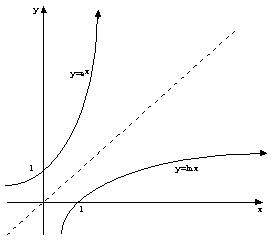
Since we know that the derivative of y = ln x is
simply 1/x, we can then find the derivative of the inverse function, the
exponential function, with respect to the x-axis, using our algorithm presented in the chapter on inverse
functions. It goes as follows:
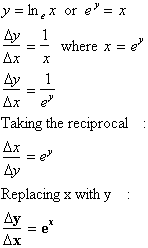
We have just found proven that the derivative of
 is the function
itself or
is the function
itself or
 y.
= y. This was done by just examining the function.s inverse, the natural
logarithm and its derivative with respect to x. This shows the close
relationship the Exponential Function has with the Logarithmic function,
the
two being inverses of one another. This concludes our study of these two
function.s and their derivatives. We will explain later how e is actually
a
number defined as a limit. For now just consider how in calculating the
derivative of the multiplicative function, the exponential function,
involved
an analysis of each term in the series of the binomial expansion, whereas
in
the study of repetitive addition functions, polynomials, all the terms
except
the second, went to zero.
y.
= y. This was done by just examining the function.s inverse, the natural
logarithm and its derivative with respect to x. This shows the close
relationship the Exponential Function has with the Logarithmic function,
the
two being inverses of one another. This concludes our study of these two
function.s and their derivatives. We will explain later how e is actually
a
number defined as a limit. For now just consider how in calculating the
derivative of the multiplicative function, the exponential function,
involved
an analysis of each term in the series of the binomial expansion, whereas
in
the study of repetitive addition functions, polynomials, all the terms
except
the second, went to zero.